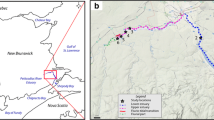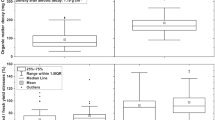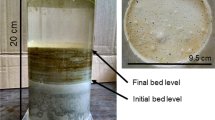Abstract
The goal of this research was to investigate size-specific retention of clay and silt-sized grains by biofilms in sandy intertidal sediments. Sediment cores were collected from an intertidal flat in Cole Harbour, NS, and eroded at increasing shear stresses (0.08–0.60 Pa) with a Gust microcosm. Half of the cores were eroded without undergoing prior treatment, while sodium hypochlorite was added to the other cores to destroy biofilms. The disaggregated inorganic grain size distribution of sediment resuspended by the Gust microcosm was then obtained with a Multisizer™ 3 Coulter Counter®, and each treated core was compared with its corresponding untreated core. Overall, significantly less total sediment mass was resuspended from untreated cores than from treated cores. At intermediate shear stresses, the sediment resuspended from treated cores contained a greater proportion of fine and medium silts than the sediment resuspended from untreated cores. Very fine silts and clays were not retained preferentially by biofilms. The results show that biofilms stabilize the sediment, but they do not necessarily enhance the proportion of finest sediment sizes, as previously proposed.








Similar content being viewed by others
References
Amos, C.L. 1995. Siliciclastic tidal flats. In Geomorphology and sedimentology of estuaries, ed. G.M.E. Perillo, 273–306. Amsterdam: Elsevier.
Baker, E.T., and J.W. Lavelle. 1984. The effect of particle size on the light attenuation coefficient of natural suspensions. Journal of Geophysical Research: Oceans 89: 8197–8203.
Bender, J., S. Rodriguezeaton, U.M. Ekanemesang, and P. Phillips. 1994. Characterization of metal-binding bioflocculants produced by the cyanobacterial component of mixed microbial mats. Applied and Environmental Microbiology 60: 2311–2315.
Billerbeck, M., H. Roy, K. Bosselmann, and M. Huettel. 2007. Benthic photosynthesis in submerged Wadden Sea intertidal flats. Estuarine, Coastal and Shelf Science 71: 704–716.
Boss, E., M. Twardowski, and S. Herring. 2001. Shape of the particulate beam attenuation spectrum and its inversion to obtain the shape of the particulate size distribution. Applied Optics 40: 4885–4893.
Cadwalader, G.O., C.E. Renshaw, B.P. Jackson, F.J. Magilligan, J.D. Landis, and B.C. Bostick. 2011. Erosion and physical transport via overland flow of arsenic and lead bound to silt-sized particles. Geomorphology 128: 85–91.
Curran, K., P. Hill, T. Schell, T. Milligan, and D. Piper. 2004. Inferring the mass fraction of floc-deposited mud: application to fine-grained turbidites. Sedimentology 51: 927–944.
Dade, W., and P. Friend. 1998. Grain-size, sediment-transport regime, and channel slope in alluvial rivers. Journal of Geology 106: 661–675.
Davies, N.S., M.R. Gibling, and M.C. Rygel. 2011. Alluvial facies evolution during the Palaeozoic greening of the continents: case studies, conceptual models and modern analogues. Sedimentology 58: 220–258.
Decho, A.W. 1990. Microbial exopolymer secretions in ocean environments—their role(s) in food webs and marine processes. Oceanography and Marine Biology 28: 73–153.
Decho, A.W. 2000. Microbial biofilms in intertidal systems: an overview. Continental Shelf Research 20: 1257–1273.
Decho, A., T. Kawaguchi, M. Allison, E. Louchard, R. Reid, F. Stephens, K. Voss, R. Wheatcroft, and B. Taylor. 2003. Sediment properties influencing upwelling spectral reflectance signatures: the “biofilm gel effect”. Limnology and Oceanography 48: 431–443.
Delgado, M., V.N. Dejonge, and H. Peletier. 1991. Effect of sand movement on the growth of benthic diatoms. Journal of Experimental Marine Biology and Ecology 145: 221–231.
Dickhudt, P.J., C.T. Friedrichs, L.C. Schaffner, and L.P. Sanford. 2009. Spatial and temporal variation in cohesive sediment erodibility in the York River estuary, eastern USA: a biologically influenced equilibrium modified by seasonal deposition. Marine Geology 267: 128–140.
Dietrich, W.E. 1982. Settling velocity of natural particles. Water Resources Research 18: 1615–1626.
Dyer, K.R. 1986. Coastal and estuarine sediment dynamics. Chichester: Wiley.
Folk, R.L. 1980. Petrology of sedimentary rocks. Austin, TX: Hemphill’s.
George, D.A., P.S. Hill, and T.G. Milligan. 2007. Flocculation, heavy metals (Cu, Pb, Zn) and the sand–mud transition on the Adriatic Continental Shelf, Italy. Continental Shelf Research 27: 475–488.
Grant, J., U.V. Bathmann, and E.L. Mills. 1986. The interaction between benthic diatom films and sediment transport. Estuarine, Coastal and Shelf Science 23: 225–238.
Grant, J., and G. Gust. 1987. Prediction of coastal sediment stability from photopigment content of mats of purple sulfur bacteria. Nature 330: 244–246.
Gomez, B. 1983. Temporal variations in bedload transport rates: the effect of progressive bed armouring. Earth Surface Processes and Landforms 8: 41–54.
Hoagland, K.D., J.R. Rosowski, M.R. Gretz, and S.C. Roemer. 1993. Diatom extracellular polymeric substances—function, fine structure, chemistry, and physiology. Journal of Phycology 29: 537–566.
Holland, A.F., R.G. Zingmark, and J.M. Dean. 1974. Quantitative evidence concerning stabilization of sediments by marine benthic diatoms. Marine Biology 27: 191–196.
Jesus, B., V. Brotas, L. Ribeiro, C.R. Mendes, P. Cartaxana, and D.M. Paterson. 2009. Adaptations of microphytobenthos assemblages to sediment type and tidal position. Continental Shelf Research 29: 1624–1634.
Keil, R.G., D.B. Montlucon, F.G. Prahl, and J.I. Hedges. 1994. Sorptive preservation of labile organic-matter in marine-sediments. Nature 370: 549–552.
Kranck, K., P.C. Smith, and T.G. Milligan. 1996. Grain-size characteristics of fine-grained unflocculated sediments. 1. ‘One-round’ distributions. Sedimentology 43: 589–596.
Law, B.A., P.S. Hill, T.G. Milligan, K.J. Curran, P.L. Wiberg, and R.A. Wheatcroft. 2008. Size sorting of fine-grained sediments during erosion: results from the western Gulf of Lions. Continental Shelf Research 28: 1935–1946.
Lundkvist, M., M. Grue, P.L. Friend, and M.R. Flindt. 2007. The relative contributions of physical and microbiological factors to cohesive sediment stability. Continental Shelf Research 27: 1143–1152.
McCave, I.N., and I.R. Hall. 2006. Size sorting in marine muds: processes, pitfalls, and prospects for paleoflow-speed proxies. Geochemistry Geophysics Geosystems 7:Q10N05.
Mehta, A.J., T.M. Parchure, J.G. Dixit, and R. Ariathurai. 1982. Resuspension potential of deposited cohesive sediment beds. In Estuarine comparisons: Proceedings of the Sixth Biennial International Estuarine Research Conference, Gleneden Beach, Oregon, November 1–6, 1981, ed. V.S. Kennedy, 591–609. New York: Academic.
Milligan, T.G., P.S. Hill, and B.A. Law. 2007. Flocculation and the loss of sediment from the Po River plume. Continental Shelf Research 27: 309–321.
Milligan, T.G., and K. Kranck. 1991. Electro-resistance particle size analyzers. In Principles, methods and applications of particle size analysis, ed. J.P.M. Syvitski, 109–118. New York: Cambridge University Press.
Milligan, T.G., and D. Loring. 1997. The effect of flocculation on the size distributions of bottom sediment in coastal inlets: Implications for contaminant transport. Water, Air, and Soil Pollution 99: 33–42.
Quaresma, V.D., C.L. Amos, and M. Flindt. 2004. The influences of biological activity and consolidation time on laboratory cohesive beds. Journal of Sedimentary Research 74: 184–190.
Reid, R., P. Visscher, A. Decho, J. Stolz, B. Bebout, C. Dupraz, L. Macintyre, H. Paerl, J. Pinckney, L. Prufert-Bebout, T. Steppe, and D. DesMarais. 2000. The role of microbes in accretion, lamination and early lithification of modern marine stromatolites. Nature 406: 989–992.
Sanford, L.P., and J.P.Y. Maa. 2001. A unified erosion formulation for fine sediments. Marine Geology 179: 9–23.
Sheldon, R.W. 1972. Size separation of marine seston by membrane and glass-fiber filters. Limnology and Oceanography 17: 494–498.
Slade, W.H., E. Boss, and C. Russo. 2011. Effects of particle aggregation and disaggregation on their inherent optical properties. Optics Express 19: 7945–7959.
Stal, L.J. 2003. Microphytobenthos, their extracellular polymeric substances, and the morphogenesis of intertidal sediments. Geomicrobiology Journal 20: 463–478.
Stal, L.J. 2010. Microphytobenthos as a biogeomorphological force in intertidal sediment stabilization. Ecological Engineering 36: 236–245.
Sutherland, T.F., J. Grant, and C.L. Amos. 1998. The effect of carbohydrate production by the diatom Nitzschia curvilineata on the erodibility of sediment. Limnology and Oceanography 43: 65–72.
Tolhurst, T.J., K.S. Black, D.M. Paterson, H.J. Mitchener, G.R. Termaat, and S.A. Shayler. 2000. A comparison and measurement standardisation of four in situ devices for determining the erosion shear stress of intertidal sediments. Continental Shelf Research 20: 1397–1418.
van de Koppel, J., P.M.J. Herman, P. Thoolen, and C.H.R. Heip. 2001. Do alternate stable states occur in natural ecosystems? Evidence from a tidal flat. Ecology 82: 3449–3461.
van Ledden, M., W.G.M. van Kesteren, and J.C. Winterwerp. 2004. A conceptual framework for the erosion behaviour of sand–mud mixtures. Continental Shelf Research 24: 1–11.
Wang, S., and C.N. Mulligan. 2006. Occurrence of arsenic contamination in Canada: sources, behavior and distribution. Science of the Total Environment 366: 701–721.
Wiberg, P., D. Drake, and D. Cacchione. 1994. Sediment resuspension and bed armoring during high bottom stress events on the Northern California inner continental shelf—measurements and predictions. Continental Shelf Research 14: 1191–1219.
Wiberg, P., and J. Smith. 1987. Calculations of the critical shear stress for motion of uniform and heterogeneous sediments. Water Resources Research 23: 1471–1480.
Yallop, M.L., B. Dewinder, D.M. Paterson, and L.J. Stal. 1994. Comparative structure, primary production and biogenic stabilization of cohesive and noncohesive marine-sediments inhabited by microphytobenthos. Estuarine, Coastal and Shelf Science 39: 565–582.
Acknowledgments
The authors wish to thank the Particle Dynamics Lab at the Bedford Institute of Oceanography for providing most field equipment. We are grateful to Vanessa Page, Laura deGelleke, John Newgard, and Claire Normandeau for help with sample processing, as well as to an anonymous reviewer for valuable feedback. This research was funded by the Natural Sciences and Engineering Research Council of Canada (NSERC) and the US Office of Naval Research (ONR) contracts N00014-08-1-1001 and N00014-10-1-0306 awarded to P.S. Hill.
Author information
Authors and Affiliations
Corresponding author
Rights and permissions
About this article
Cite this article
Garwood, J.C., Hill, P.S. & Law, B.A. Biofilms and Size Sorting of Fine Sediment During Erosion in Intertidal Sands. Estuaries and Coasts 36, 1024–1036 (2013). https://doi.org/10.1007/s12237-013-9618-z
Received:
Revised:
Accepted:
Published:
Issue Date:
DOI: https://doi.org/10.1007/s12237-013-9618-z




